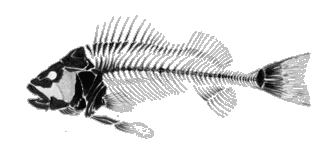|
Avila beach is home
to a huge variety of bony fishes. One of the goals of the Cal
Poly pier is to get a closer look at the numerous species that
inhabit the surrounding waters with a flowing sea water lab. This
would allow students and researchers to study bony fishes and
get a better understand of each individual species by observing
them instead of reading about them in a book.
Scientific
Classification
Phylum – Chordata
Class – osteichthyes
Distribution
and Habitat
There are more than 23,500 species of bony fishes that inhabit
almost ever body of water. Depending on the species, bony fishes
can live at various temperatures, but the water at Avila Beach
is usually around 55 °F.
Physical Characteristics
These cold blooded animals breathe through their gills and use
fins for swimming. The five traits that all bony fishes have in
common include: a skeleton made of bones, paired fins, one pair
of gill openings, jaws, and paired nostrils.
Coloration of bony fishes is an important survival trait. In some
species of bony fishes, coloration serves as advertisement to
other fishes for species recognition and sexual distinction. Most
species of fish are countershaded. Countershading is a type of
camouflage in which the dorsal, or topside, of the fish is darker
than the ventral side, or underside. The dorsal side of a countershaded
fish blends in with the dark ocean depths or ocean bottom when
viewed from above. The ventral side blends in the with lighter
surface of the sea when viewed from below. Under ideal circumstances,
neither the fish’s predators not the fish’s prey can
differentiate between the countershaded animal and the environment.
As do other classes of fished, bony fishes secrete a layer of
mucus that covers the entire body to help protect that fish from
infection.
Behavior
Many species of bony fishes swim together in schools. This behavior
acts as a protection factor by allowing the school to give the
impression of a large animal to discourage predators. Another
way that some bony fishes protect themselves is to dwell on the
ocean floor.. These types of fish are often reffered to as benthic
feeders meaning that they get their food on the bottom of the
ocean.
Conservation
Issues
As of 1993, over 100
species of native bony fishes were considered endangered or threatened
with extinction by the U.S. Fish and Wildlife Service. Legal protection
for these fish include fishing laws and regulations as well as
international cooperation for conservation.
|

